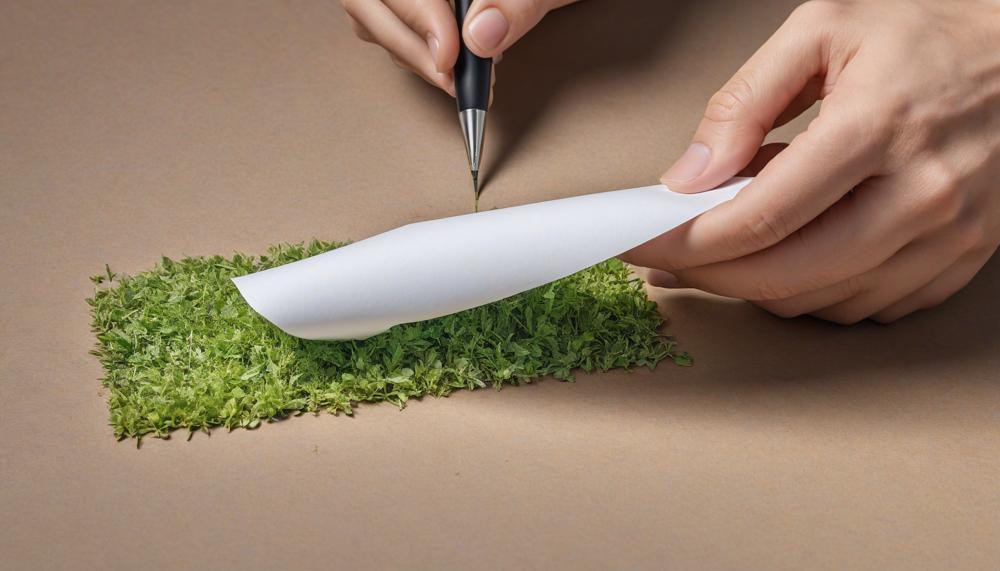Ever wondered what happens to that piece of paper after you toss it away? The answer might surprise you. Paper, crafted from wood and plant fibers, is inherently biodegradable, but its decomposition timeline isn’t set in stone. Under ideal conditions—think humid, wet, and warm—it can break down in just two months. Conversely, in drier environments, the process slows significantly.
The type of paper also plays a crucial role: while printing paper might vanish in under six months, photo paper lingers for 4-8 months, and tissue paper takes around five months. Surprisingly, paper towels decompose in about two months, and paper bags, given a bit of moisture, are fully compostable within the same timeframe.
Why does this matter? Unlike plastic, which can linger for millennia, paper offers a more sustainable alternative, both biodegradable and recyclable. Here’s what you need to remember:
- Paper biodegrades faster in humid, wet, and warm conditions.
- Dry environments slow down the decomposition process.
- Different types of paper decompose at different rates:
- Printing paper: andlt;6 months
- Photo paper: 4-8 months
- Tissue paper: ~5 months
- Paper towels: ~2 months
- Paper bags: ~2 months with moisture
- Paper is more sustainable than plastic, which is neither biodegradable nor sustainable.
Understanding the biodegradation of paper isn’t just about curiosity—it’s about recognizing the environmental impact of our everyday choices.
Contents
- 1 Is paper environmentally friendly?
- 2 Is paper terrible for the environment?
- 3 The Environmental Impact Of Using Paper
- 4 The Best Way To Dispose Of Paper
- 5 Can I Compost Paper at Home?
- 6 How Long Does It Take For Paper To Decompose
- 7 Are Coffee Filters Compostable? But Are They Worth the Effort?
- 8 Is human hair biodegradable?
- 9 Conclusion
Is paper environmentally friendly?
Paper, crafted from wood and other plant fibers, is inherently biodegradable. However, the environmental impacts of paper use are multifaceted. While paper is preferable to plastic due to its biodegradability and recyclability, it comes with significant ecological costs.
The production process involves harvesting vast numbers of trees—about 42 million daily—contributing to deforestation. Furthermore, manufacturing paper often entails air and water pollution due to chemical treatments and energy consumption.
Paper’s ability to biodegrade varies based on its type and the environmental conditions. Humid, wet, and warm environments facilitate faster decomposition, whereas dry conditions slow it down. Here’s a detailed look at how long different types of paper take to biodegrade:
| Type of Paper | Biodegradation Time | Additional Information |
| Printing Paper | Less than 6 months | Decomposes faster in humid and warm conditions |
| Cardboard | 3 to 10 months | Slower decomposition in dry conditions |
| Tissue Paper | Around 5 months | Biodegradable but not recyclable |
| Paper Bags | 2 months | 100% biodegradable, compostable, and recyclable |
While paper is more environmentally friendly compared to plastic, its production and disposal have significant environmental impacts. The biodegradation process ranges from 2 weeks to 6 months, depending on the type of paper and environmental conditions.
Is paper terrible for the environment?
Yes, paper can significantly harm the environment due to multiple factors associated with its production, usage, and disposal. Here’s how paper contributes to environmental degradation:
| Aspect | Impact | Details |
| Deforestation | Severe | 4 billion trees are felled annually for paper, representing 35% of global tree harvests. This deforestation leads to habitat loss, reduced biodiversity, and contributes to climate change by removing carbon sinks. |
| Greenhouse Gas Emissions | High | Paper production is a major source of greenhouse gases. The degradation of paper in landfills generates methane, a potent greenhouse gas with a heat-trapping capacity far greater than CO2. |
| Landfill Space | Significant | Paper accounts for 26% of landfill waste. As it decomposes, it produces methane, contributing to global warming and occupying valuable landfill space. |
| Water Pollution | Critical | The paper manufacturing process releases toxic chemicals into water bodies, harming aquatic life and disrupting ecosystems. |
| Illegal Logging | Destructive | Illegal logging driven by the paper industry threatens natural habitats and biodiversity, leading to the loss of critical ecosystems. |
| Recycling | Beneficial | Recycling paper helps mitigate environmental damage by reducing the need for new trees, saving landfill space, and using less energy than producing new paper. |
By understanding these impacts, we can see that while paper is a common and necessary product, its environmental footprint is substantial. Efforts to reduce, reuse, and recycle paper, along with sustainable production practices, are essential to lessen its adverse effects.
The Environmental Impact Of Using Paper
The production of paper has significant adverse effects on the environment at every stage of its lifecycle. Here’s a detailed look at these negative impacts:
| Lifecycle Stage | Environmental Impact | Description |
| Production | Deforestation | The paper industry drives large-scale deforestation, leading to habitat loss and decreased biodiversity. It disrupts ecosystems and reduces the earth’s capacity to absorb CO₂. |
| Manufacturing | Greenhouse Gas Emissions | Paper manufacturing is a major industrial source of CO₂ and other greenhouse gases. It contributes significantly to global warming. Energy supply to paper plants further exacerbates this issue. |
| Water Pollution | Wastewater Discharge | The process discharges pollutants, including chlorine and other chemicals, into water bodies, affecting aquatic life and water quality. |
| Usage | High Water and Energy Consumption | Paper production consumes vast amounts of water and energy. Producing a single A4 sheet can require up to 10 litres of water. |
| Disposal | Landfill Contribution | Discarded paper takes up considerable landfill space. As it decomposes, it releases methane, a potent greenhouse gas that intensifies global warming. |
| Illegal Logging | Unsustainable Practices | Illegal logging for paper pulp harms forests and communities. It undermines conservation efforts and promotes environmental degradation. |
The Best Way To Dispose Of Paper
The best way to dispose of paper effectively and environmentally is by focusing on methods that minimize harm and maximize resource reuse. Here are the most recommended approaches:
Recycling:
Recycling is the most effective way to manage paper waste. By placing used paper in recycling bins, you ensure it gets processed and repurposed into new paper products. This reduces the need for virgin materials, saving trees and conserving water and energy.
| Benefits | Considerations |
| Reduces deforestation | Ensure paper is clean and dry |
| Conserves water and energy | Remove any non-paper materials |
| Minimizes landfill waste | Check local recycling guidelines |
Composting:
Composting paper, especially non-glossy types like newspapers and cardboard, turns it into valuable compost that enriches soil. Shred or tear the paper into small pieces to speed up the decomposition process.
| Benefits | Considerations |
| Enriches soil naturally | Avoid glossy or coated papers |
| Reduces landfill use | Shred paper for faster decomposition |
| Supports sustainable gardening | Mix with other compost materials |
Certified Shredding Services:
Using certified shredding services that recycle shredded materials ensures both security and sustainability. These services protect sensitive information while ensuring the shredded paper is recycled properly.
| Benefits | Considerations |
| Protects sensitive information | Ensure the service is certified |
| Guarantees recycling | May incur a cost |
| Convenient and professional | Schedule regular pickups |
Digital Alternatives:
Reduce paper waste by opting for digital solutions. Use digital receipts, online documents, and digital storage to minimize the need for physical paper. Print only when absolutely necessary and always double-sided.
| Benefits | Considerations |
| Significantly reduces paper use | Ensure digital security |
| Convenient and accessible | Requires digital literacy |
| Cost-effective in the long run | Invest in reliable digital storage |
By incorporating these methods into your routine, you not only dispose of paper responsibly but also contribute to a more sustainable environment.
Can I Compost Paper at Home?
The short answer is yes, you can compost paper at home safely. When composted correctly, paper breaks down and enriches your compost pile without causing harm.
The decomposition process typically takes 2 to 6 weeks in a well-maintained compost heap, though it can stretch to 2 to 5 months under less optimal conditions.
To ensure safety and efficiency:
- Preparation: Shred or cut paper into small pieces. This increases the surface area, facilitating quicker decomposition and maintaining oxygen flow.
- Balance: Mix the shredded paper with nitrogen-rich green materials (like kitchen scraps) and other carbon-rich brown materials (like dried leaves). Aim for a carbon:nitrogen ratio of 25:1 to 30:1.
- Avoid Contaminants: Do not compost paper contaminated with dairy, meat, manure, or oil. These attract pests and cause odours.
- Moisture and Aeration: Keep the pile moist but not waterlogged. Regularly turn the compost to maintain air flow, preventing foul smells and ensuring efficient breakdown.
- Hot Composting: This method can speed up decomposition due to its ability to retain heat and moisture but requires regular turning and temperature monitoring.
| Action | Details | Benefits |
| Shredding paper | Cut paper into small pieces before adding | Speeds up decomposition, maintains oxygen flow |
| Balancing materials | Mix shredded paper with green (nitrogen) and brown (carbon) materials | Ensures proper decomposition, maintains carbon:nitrogen ratio |
| Avoiding contaminants | Do not compost paper with dairy, meat, manure, or oil | Prevents pests and bad odours |
| Maintaining moisture | Keep the pile moist, not waterlogged | Supports microbial activity, prevents foul smells |
| Turning the pile | Regularly turn the compost | Improves aeration, speeds up decomposition |
How Long Does It Take For Paper To Decompose
The time it takes for paper to decompose varies significantly, from a few weeks to several years.
Several factors influence this process, including temperature, moisture, sunlight exposure, presence of microorganisms, and whether the paper is buried or exposed.
| Factor | Impact on Decomposition | Details |
| Temperature | Accelerates with warmth | Higher temperatures increase microbial activity, speeding up decomposition. |
| Moisture | Speeds up decomposition | Moist conditions promote microbial growth, essential for breaking down paper. |
| Sunlight Exposure | Variable effect | Direct sunlight can dry out paper, slowing decomposition, but UV rays can break down fibers over time. |
| Microorganisms | Crucial for decomposition | Microbes and fungi decompose organic matter; more microbes mean faster decomposition. |
| Burial vs. Exposure | Burial can slow down, exposure can vary | Buried paper decomposes slower due to less air and microbial activity; exposed paper can decompose faster if conditions are right. |
Are Coffee Filters Compostable? But Are They Worth the Effort?
Yes, coffee filters are generally both biodegradable and compostable.
However, whether they are worth the effort to dispose of in an environmentally friendly way depends on several factors, including the type of filter and personal environmental priorities.
Biodegradability and Compostability of Coffee Filters
Most coffee filters, made from paper, are designed to be biodegradable. This means they can be broken down by microorganisms into natural elements like carbon dioxide, water, and biomass. Compostable filters take this a step further by decomposing into nutrient-rich soil, enhancing soil health.
Types of Coffee Filters
| Type of Filter | Biodegradable | Compostable |
| Bleached Paper Filters | Yes | Yes, but slower due to chemicals |
| Unbleached Paper Filters | Yes | Yes, decomposes faster |
| Reusable Cloth Filters | No | No |
| Metal Filters | No | No |
Factors Affecting Decomposition
The rate at which coffee filters decompose depends on various factors:
- Type of Paper: Unbleached filters decompose faster than bleached ones.
- Composting Conditions: Adequate oxygen and moisture levels can reduce decomposition time to 2-5 weeks.
- Landfill Conditions: Limited oxygen and moisture can extend decomposition to several months or years.
Environmental Impact
Using biodegradable and compostable coffee filters can reduce landfill waste and contribute to soil health. However, the production of these filters can have environmental costs, including water and energy consumption and potential deforestation. Sustainable sourcing of paper is crucial.
Effort vs. Benefit
If you’re committed to reducing waste and promoting sustainability, composting coffee filters is worthwhile. For those prioritizing convenience, traditional disposal methods may seem more practical.
Is human hair biodegradable?

Yes, human hair is biodegradable. However, it takes several years for it to decompose naturally. Human hair’s unique composition, primarily keratin, makes it resistant to decomposition.
The natural breakdown of hair can take between one to two years when buried in soil, depending on environmental factors such as temperature, moisture, and microbial activity.
| Biodegradability | Decomposition Time | Environmental Factors |
| Human Hair | 1-2 years | Temperature, moisture, microbial activity |
| Synthetic Hair | Not biodegradable | Can have negative environmental impacts |
Conclusion
Paper biodegrades swiftly compared to many materials, making it a more eco-friendly option for waste management.
Under optimal conditions—moisture, warmth, and microorganisms—paper can decompose within two months. However, various factors affect this timeline.
For instance, printing paper typically biodegrades within six months, while tissue paper takes around five months, and photo paper can last 4-8 months. Humidity and warmth accelerate this process, whereas dry environments slow it down.
The environmental benefits of paper biodegradation are significant. Unlike plastics, which can persist for centuries, paper reduces landfill volume and methane emissions when it breaks down.
This rapid biodegradation, combined with its recyclability, underscores paper’s role as a more sustainable alternative.





